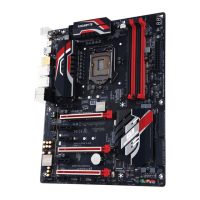
Do you have a question about the Gigabyte GA-Z170X-Gaming 5 and is the answer not in the manual?
| ECC | Yes |
|---|---|
| Internal memory | 64 GB |
| Memory channels | Dual-channel |
| Memory slots type | DIMM |
| Supported memory types | DDR4-SDRAM |
| Supported memory clock speeds | 2133, 2400, 2666, 2800, 3000, 3200, 3300, 3333, 3400, 3466 MHz |
| Processor socket | LGA 1151 (Socket H4) |
| Processor manufacturer | Intel |
| Compatible processor series | Intel Celeron, Intel Pentium |
| Intel® Core i3/i5/i7/i9 series | i3-6xxx, i5-6xxx, i7-6xxx |
| PCI Express x1 slots | 4 |
| PCI Express x16 slots | 3 |
| Number of M.2 (M) slots | 2 |
| Thunderbolt headers | 1 |
| Number of SATA connectors | 9 |
| Number of SATA III connectors | 6 |
| USB 3.2 Gen 2 (3.1 Gen 2) connectors | 0 |
| BIOS type | AMI |
| ACPI version | 5.0 |
| BIOS memory size | 32 Mbit |
| RAID levels | 0, 1, 5, 10 |
| Supported storage drive interfaces | SATA II, SATA III |
| HDMI version | 1.4 |
| Headphone outputs | 5 |
| DisplayPort version | 1.2 |
| USB 2.0 ports quantity | USB 2.0 ports have a data transmission speed of 480 Mbps, and are backwards compatible with USB 1.1 ports. You can connect all kinds of peripheral devices to them. |
| Component for | PC |
| Motherboard chipset | Intel® Z170 |
| Audio output channels | 7.1 channels |
| Motherboard form factor | ATX |
| Windows operating systems supported | Windows 10 Education, Windows 10 Education x64, Windows 10 Enterprise, Windows 10 Enterprise x64, Windows 10 Home, Windows 10 Home x64, Windows 10 Pro, Windows 10 Pro x64, Windows 7 Enterprise, Windows 7 Enterprise x64, Windows 7 Home Basic, Windows 7 Home Basic x64, Windows 7 Home Premium, Windows 7 Home Premium x64, Windows 7 Professional, Windows 7 Professional x64, Windows 7 Starter, Windows 7 Starter x64, Windows 7 Ultimate, Windows 7 Ultimate x64, Windows 8.1, Windows 8.1 Enterprise, Windows 8.1 Enterprise x64, Windows 8.1 Pro, Windows 8.1 Pro x64, Windows 8.1 x64 |
| Cables included | SATA |
| Bundled software | Norton Internet Security (OEM version) Intel Smart Response Technology |
| LAN controller | Atheros Killer E2201 |
| Ethernet interface type | Gigabit Ethernet |
| Depth | 244 mm |
|---|---|
| Width | 305 mm |
Lists items included in the product package, such as motherboard, driver disk, manual, and cables.
Essential guidelines and safety procedures to follow before installing hardware components.
Step-by-step guide and precautions for installing the CPU and its cooler.
Guidelines and important considerations for installing memory modules, including dual channel configuration.
Guidelines for installing expansion cards, emphasizing precautions.
Details on supported CPUs, package, cache, and the Intel Z170 Express Chipset.
Specifications for DDR4 memory and integrated graphics processor capabilities.
Information on audio codec, LAN chips, and PCI Express slot configurations.
Support for AMD CrossFire and NVIDIA SLI technologies.
Specifies M.2, SATA Express, and SATA connectors and RAID support.
Details on USB 3.0/2.0, USB 2.0/1.1, and Thunderbolt 3 controller ports.
Identifies and lists internal connectors with their corresponding numbers on the motherboard diagram.
Details the 24-pin ATX and 8-pin 12V power connectors and their pin assignments.
Explains the CPU_FAN, CPU_OPT, and SYS_FAN headers, including pinouts and speed control.
Specifics for the CPU_OPT (Water Cooling CPU Fan Header) pinout and function.
Information on SATA Express connectors and their support for single SATA Express devices.
Details SATA 6Gb/s connectors, compatibility, and RAID support.
Explains the battery's role in CMOS and how to clear CMOS by removing it.
Describes the S/PDIF Out header for digital audio output and its connection requirements.
Details M.2 connectors, support for SATA/PCIe SSDs, and RAID configuration.
Tables detailing supported M.2 SSD configurations for AHCI and RAID modes.
Explains front panel header connections for power switch, LEDs, reset, and speaker.
Details the front panel audio header for HD and AC'97 audio connections.
Pinout and description for USB 3.0/2.0 front panel headers.
Pinout and description for USB 2.0/1.1 front panel headers.
Pinout and description for the Trusted Platform Module header.
Details the connector for GIGABYTE Thunderbolt add-in cards.
Pinout and description for the onboard serial port header.
Instructions for using the jumper to clear CMOS settings and reset BIOS defaults.
Identifies rear panel connectors including USB, audio, video, and network ports.
Details on USB 2.0/1.1, USB Type-C, and USB 3.0/2.0 ports.
Explains the function and specifications of DisplayPort and HDMI outputs.
Describes the Gigabit Ethernet LAN ports and their LED status indicators.
Details the various audio jacks for speaker output, line-in, and S/PDIF out.
Details I/O controller chip and hardware monitoring capabilities like temperature and fan speed.
Information on BIOS flash utility, DualBIOS, and unique features like APP Center applications.
Lists bundled software and specifies the motherboard's physical form factor.
Outlines the necessary hardware and software for CrossFire/SLI setup.
Steps for physically installing multiple graphics cards and bridge connectors.
Instructions for enabling CrossFire and SLI functions via driver software.
Explains the function of the ECO and OC buttons for power saving and overclocking.
Describes the audio gain control switch and its DIP settings.
Provides step-by-step instructions for replacing the operational amplifier.
Describes the initial GIGABYTE logo screen that appears during system boot.
Provides status information for CPU, memory frequencies, and voltages.
Provides current status information for CPU, memory frequencies, and voltages.
Options for performance upgrades, CPU base clock, and CPU frequency adjustments.
Allows manual setting of CPU frequency and clock ratio for performance tuning.
Shows the current operating CPU frequency.
Configuration for CPU core ratio, Uncore frequency, Turbo Boost, and power limits.
Controls for CPU core count, Hyper-Threading, and C-state power saving features.
Settings for processor C-state limits and CPU thermal monitoring.
Controls for Intel Speed Step Technology and Extreme Memory Profile for memory performance.
Options to set memory multiplier and view operating memory frequency.
Options for memory detection, training, and performance enhancement profiles.
Settings for memory multiplier, channel interleaving, rank interleaving, and sub-timings.
Controls for CPU Vcore, VAXG voltage, Chipset, and DRAM voltage adjustments.
Displays system voltages and allows resetting chassis intrusion status.
Displays CPU, PCH, and system temperatures and sets warning thresholds.
Options to adjust fan speed for CPU, CPU_OPT, and System fans based on temperature.
Settings for PCI Express link speed and legacy benchmark enhancement.
Displays motherboard model, BIOS version, and date information.
Displays motherboard model, BIOS version, and date information.
Allows selection of system language and manual setting of system date and time.
Configures boot order, security options, and boot process behavior.
Configures the system's boot order from available storage devices.
Specifies boot order for specific device types like hard drives and optical drives.
Settings for NumLock state and password protection for system access.
Options to speed up boot process and configure SATA device behavior.
Settings for VGA output type and USB device functionality during boot.
Options for PS/2 device support and network booting.
Controls for Compatibility Support Module and LAN PXE boot option ROM.
Settings for storage device and other PCI device ROM priority.
Procedures for setting administrator and user passwords for BIOS access.
Configures onboard devices like PTT, LAN, Audio, and USB support.
Enables or disables Intel PTT technology for security features.
Selects the primary display output from PCIe slots or onboard graphics.
Controls for onboard LAN functionality and audio LED behavior.
Settings for legacy USB support and XHCI hand-off for USB compatibility.
Enables/disables USB storage support and lists connected USB devices.
Information on M.2 PCIe SSDs and Trusted Computing 2.0 features.
Settings for TPM security device and its interface type.
Controls for serial port and Intel BIOS Guard technology.
Enables/disables SATA controllers and selects between AHCI and RAID modes.
Configures chipset features like VT-d, graphics, audio, and LAN.
Settings for Intel Virtualization Technology for Directed I/O and onboard graphics.
Options to allocate onboard graphics memory size.
Controls for onboard audio function and audio DSP.
Settings for Intel GbE LAN and Wake on LAN features.
Enables or disables the High Precision Event Timer (HPET).
Configures system power states, wake-up events, and energy saving features.
Determines system state after AC power loss and keyboard/mouse wake-up options.
Sets a password to enable system power-on via keyboard.
Mouse wake-up options and ErP support for low power consumption.
Configures power button behavior and power supply load settings.
Controls for USB DAC power and system power-on by alarm time.
Settings for graphics standby mode and active state power management.
Saves BIOS settings, loads defaults, and manages boot options.
Saves BIOS changes and exits the setup program.
Exits BIOS setup without saving any changes.
Loads default BIOS settings to optimize system operation.
Options for immediate boot device selection and saving/loading BIOS settings profiles.
Guide to configuring RAID arrays, including RAID levels and array capacity.
Steps to configure SATA controller mode in BIOS Setup for RAID or AHCI.
Instructions for setting up UEFI RAID with Windows 10/8.1 64-bit.
Steps to configure a RAID array using the legacy RAID BIOS utility.
Guidance on installing SATA RAID/AHCI drivers during OS installation.
Instructions for installing the operating system before driver installation.
Using the Xpress Install utility to automatically install recommended drivers.
Table listing debug LED codes and their corresponding descriptions during regular boot.
Lists debug codes related to PCI bus, USB, IDE, and SCSI initialization.
Debug codes related to S3 resume, recovery mode, and firmware issues.
Lists common error codes related to CPU, memory, and IOH initialization.
Further error codes, S3 resume failures, and recovery capsule issues.
Legal notices regarding document usage, accuracy, and changes.
GIGABYTE's commitment to environmental directives like RoHS and WEEE.
FCC compliance statement for Class B digital devices and measures to correct interference.
Compliance statements for Canadian ICES-003 and RSS-210 standards.
Information on how to contact GIGABYTE for technical support and sales inquiries.
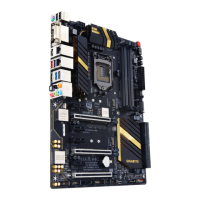
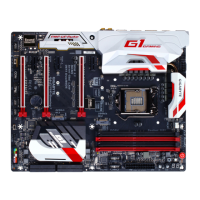
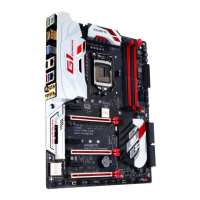
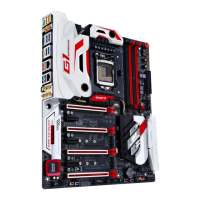
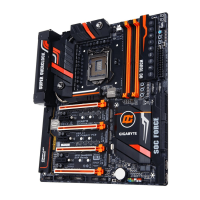

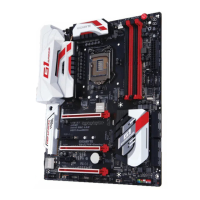
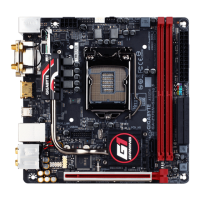
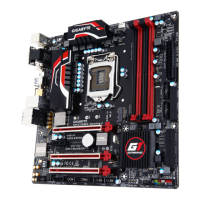
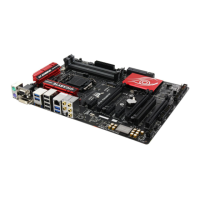
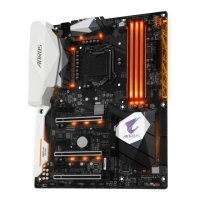
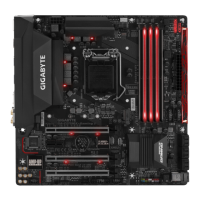
